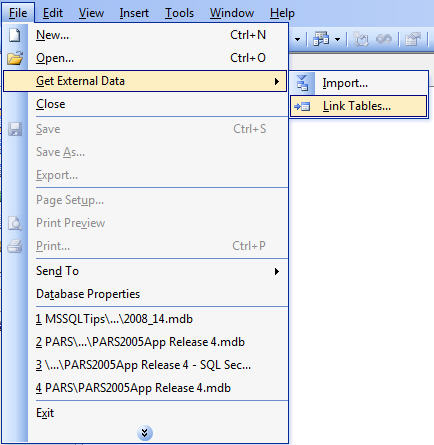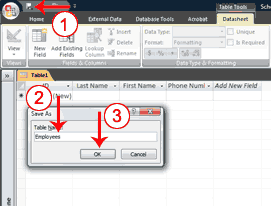


Use this to set any of the startup properties. When you call the procedure, be sure to pass the appropriate startup option text, as follows: Call SetStartupOptions("AllowBypassKey", dbBoolean, False)Īfter setting this property during the close process, the database will ignore the key bypass if one of your users is wily enough to try it. Dim dbs As Object Dim prp As Object Set dbs = CurrentDb On Error Resume Next dbs.Properties(propname) = prop If Err.Number = 3270 Then Set prp = dbs.CreateProperty(propname, _ propdb, prop) prp End If Set dbs = Nothing Set prp = Nothing End Sub
Setting up microsoft access database code#
Automate this process by calling the following code from a close task - just which task is up to you: Public Sub SetStartupOptions(propname As String, _ propdb As Variant, prop As Variant) 'Set passed startup property. To close the bypass crack, set the AllowBypassKey property to False when the database closes. That's why there's a bypass to the bypass. You can use the interface to hide the Database window, but the key bypass renders the database vulnerable to anyone who knows about it. A user can also import objects into a blank database to bypass startup settings. That trick's handy for you, but leaves the database vulnerable to anyone else who knows about it. Users can bypass all these options by holding down the key while opening the database. That option is in the Navigation section just below the Application Options section.ĭeselecting the Display Database Window option will also disable the Startup command. Access 2007 doesn't have a Database window, but you can hide the Navigation Pane in a similar manor. Select Current Database in the left pane and you'll find these options in the Application Options section. In Access 2007, click the Office button and then click the Access Options button. To access the Startup options, choose Startup from the Tools menu. If you don't deselect the Use Access Special Keys option, users can press F11 to unhide the Database window. Set startup options to hide the Database window.īoth settings work together. Use Access Special Keys: Deselect this option to inhibit the use of F11 to unhide the Database Window.Users won't have immediate access to any objects. Display Database Window: Deselect this option, and the next time someone opens the database, Access will hide the Database window.Two of these features lend a hand toward securing your database a bit: Startup options, shown in Figure B, let you determine specific behaviors when the database opens. Use the AutoExec macro to initiate important security settings.

For instance, the macro in Figure A runs a user-defined function named Startup(), which does the real work of checking and setting security properties before the user can go to work.

To create an AutoExec macro, simply name a new macro AutoExec. AutoExec is a special macro that executes when the database opens. Use the AutoExec macro to check and reset security options that processes might have changed during the last work session. 1: Check and reset settings using the AutoExec macro
Setting up microsoft access database pdf#
Note: This article is also available as a PDF download. But by combining a number of them, you can get a level of security that's better than no security at all. These tips don't offer reliable security, in and of themselves. Just keep in mind that the following tips prevent accidents by honest users and the mildly curious with enough knowledge to be dangerous. When the best security measures aren't possible (or necessary), you can implement less robust security measures to protect your data and design. User-level security is complicated and deploying it takes time and special knowledge. In the Access world, the next best thing is the user-level model (which Access 2007 doesn't even support). The operating system employs the best security, but it's not always practical, especially on a stand-alone system. That's why it's so important to protect it. Even if the data isn't directly involved in the exchange of goods or services, it still has value. Here are some simple ways to add a few layers of security to a database.ĭata is an asset. A few best practices can go a long way toward protecting your Access data from careless or overly curious users.


 0 kommentar(er)
0 kommentar(er)
